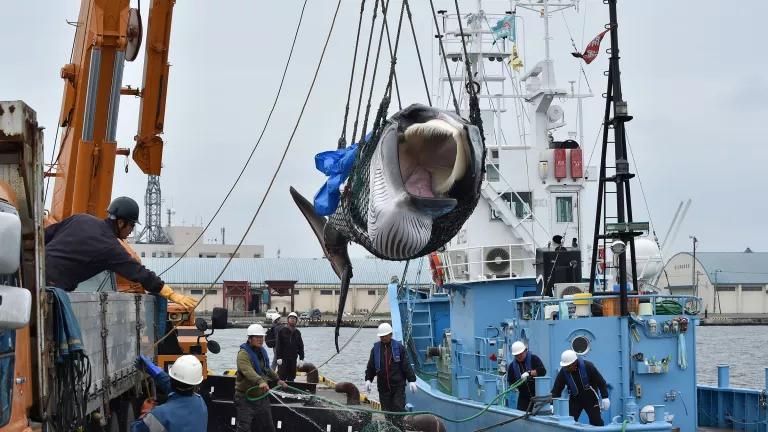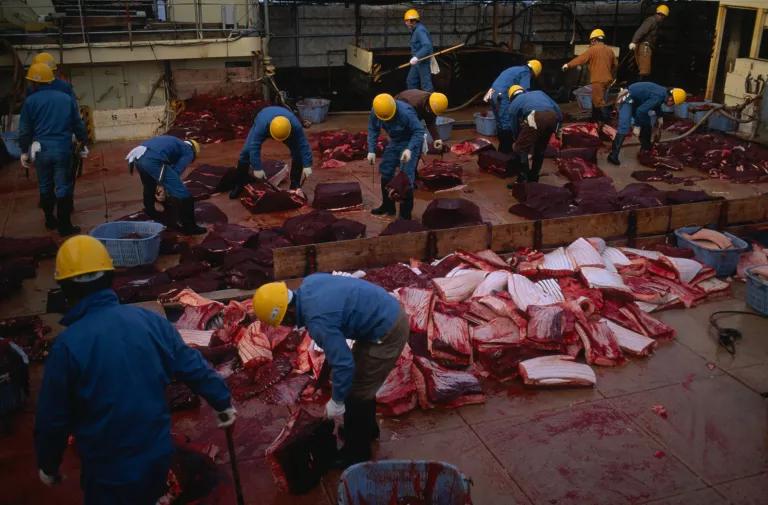Japan Goes Rogue and Resumes Commercial Whaling
The nation’s departure from the International Whaling Commission was followed immediately by the slaughter of two minke whales.

A captured minke whale in Kushiro, Hokkaido Prefecture, Japan, on July 1, 2019
It’s official.
On July 1, the day after Japan officially withdrew from the International Whaling Commission, its fishing fleet slaughtered two minke whales off the island nation’s northern coast. This is the first time Japan has hunted whales commercially since the IWC declared a moratorium on the practice 31 years ago.
The choice was made despite the fact that demand for whale meat in Japan has plummeted. In 1962, the country’s whale meat production peaked at 226,000 tons, but by 2017, that number had dropped to just 3,000 tons, or slightly more than 1 percent of the industry’s record. Japan also imports whale meat from whaling nations like Iceland and Norway, despite the lack of domestic demand. As of April, 3,500 tons of whale meat were sitting in freezers waiting for someone to buy it.
And the decision is not about creating jobs, either. Japan’s whaling industry employs just 300 people and is heavily subsidized by the government, which kicks in nearly $50 million each year to keep whalers afloat. At the same time, the country’s whale-watching industry doubled in size between 1998 and 2015, with one marine mammal outfit in Okinawa reporting 18,000 visitors between January and March of this year.
When asked what he thought about Japan’s decision to exit the IWC, Ari Friedlaender, a marine ecologist at the University of California, Santa Cruz, had one word: “Bad.”
“I’ve been involved in the IWC and whale research for a long time, and I just don’t personally have a reason to think that commercial whaling needs to exist,” says Friedlaender.
While two of the species Japan plans to target—minke and Bryde’s whales—aren’t in immediate danger of extinction, a third type, the sei whale, is considered endangered by the International Union for Conservation of Nature.
Furthermore, Friedlaender says, humans don’t have the best track record when it comes to sustainably harvesting these animals. He is referring to the nearly 3 million whales estimated to have been killed in the 20th century, a tally that put numerous species on the Endangered Species List, including right whales, fin whales, and sperm whales.
“It’s kind of the ‘Fool me once, shame on you; fool me twice shame on me’ scenario,” he says. “We’ve done commercial whaling in the past, and it led to one of the greatest ecological impacts that we’ve ever had on the ocean.”

Even if Japan has not been whaling commercially for the past several decades, the nation’s fleet has still been active, says Taryn Kiekow Heimer, deputy director of NRDC’s Marine Mammal Protection Project. “The moratorium on commercial whaling prohibits killing whales for a profit,” she explains. “There are exceptions for what’s called aboriginal subsistence whaling, and there is also a loophole that allows for the lethal take of whales for scientific purposes.”
In fact, one report by the Environmental Investigation Agency estimated that Japan has killed more than 22,000 whales for such “scientific research” since the IWC moratorium took effect. The meat is then sold domestically, purportedly as a way to generate revenue for more scientific whaling. (Yes, you read that right.)
In 2018 the Standing Committee of the Convention on International Trade in Endangered Species of Wild Fauna and Flora (CITES) ruled that Japan’s sales of endangered sei whale meat violated international law. According to the Washington Post, CITES gave the country until February 1, 2019, to “remedy its noncompliance and report back.”
But the country chose another path: leaving the IWC altogether. In some ways, that move won’t change much since, according to quotas set by the government in Tokyo, the Japanese whaling fleet is free to kill about the same number of whales as it did under previous regulations. One significant development, however, is that the whale hunting will move from the oceans near Antarctica to the waters of Japan’s own exclusive economic zone in the northern Pacific. And that’s bad news. “Since [the Japanese whalers] are now working in a much smaller area, where we know the abundances of the species that they’re interested in taking are much lower, the numbers are likely to have more of an impact than they have in the past,” says Friedlaender.
Japan’s waters are also home to a small population of minke whales known as the J-Stock, which scientists believe may be genetically and behaviorally distinct from other minke whales. The J-Stock is “incredibly endangered,” says Heimer, “and Japan could be taking some of these animals.”
But perhaps the worst thing to come from Japan’s withdrawal from the international treaty is that it could inspire other countries to do the same. “South Korea, China, Russia—those are countries that have always wanted to do commercial whaling but haven’t because they’ve been constrained by the moratorium,” says Heimer.
The good news? All the numbers suggest that whaling is a dying industry, kind of like coal mining. One can hope that whaling will go through its final death throes sooner rather than later, allowing the world’s largest mammals to continue to rebound after centuries of slaughter.
This article was originally published on onEarth, which is no longer in publication. onEarth was founded in 1979 as the Amicus Journal, an independent magazine of thought and opinion on the environment. All opinions expressed are those of the authors and do not necessarily reflect the policies or positions of NRDC. This article is available for online republication by news media outlets or nonprofits under these conditions: The writer(s) must be credited with a byline; you must note prominently that the article was originally published by NRDC.org and link to the original; the article cannot be edited (beyond simple things such grammar); you can’t resell the article in any form or grant republishing rights to other outlets; you can’t republish our material wholesale or automatically—you need to select articles individually; you can’t republish the photos or graphics on our site without specific permission; you should drop us a note to let us know when you’ve used one of our articles.

Finally, a High Seas Treaty to Protect the World’s Oceans
Can Anything Be Done to Stop Overfishing?
Biodiversity 101